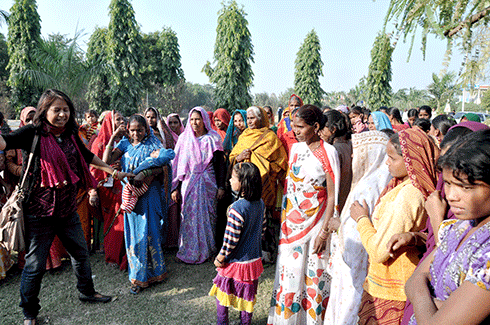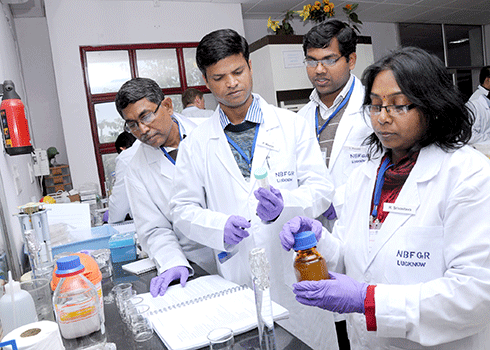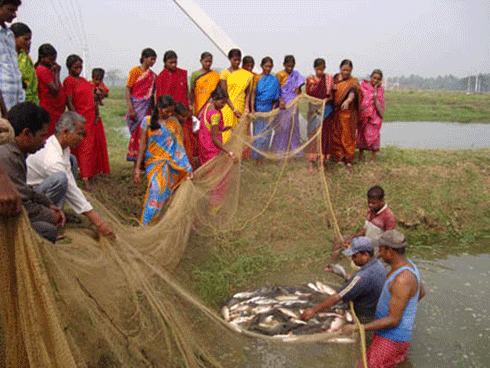
|
Published: 3 March 2014
Safer water: helping a neighbour in need
In India, increased demand for limited water resources from a growing population – along with pollution from urban and industrial development – are reducing water quantity and quality. While the problem is not new, India’s capacity to respond continues to be limited.

|
|
CSIRO scientist, Dr Anu Kumar (left) discusses river health with women from a fishing village near Lucknow, India (see box below). Credit:
CSIRO
|
Late last year, a team from CSIRO travelled to India to share their expertise in ecotoxicology – the study of the impact of chemicals on organisms – through leading local workshops. The team comprised Dr Anu Kumar, Dr Peter Bain and Merrin Adams from CSIRO Land and Water, and Dr Jenny Stauber from CSIRO’s Water for a Healthy Country Flagship.
Dr Kumar ran a workshop at the National Bureau of Fish Genetic Resources (NBFGR) in Lucknow, training Indian scientists, regulators, academics and consultants in ecotoxicological techniques. The workshop is part of a 3-year project, Safe Water for the Future through Indo-Oz Network, funded by AusAID (now part of the Department of Foreign Affairs and Trade).
‘There would only be a couple of labs undertaking ecotoxological studies following standard protocols or developing new bioassays using native species,’ says Dr Kumar.
‘We showed how ecotoxicological assessment can be done locally, using native species: [for example, by exposing] native carp in the laboratory to sewage effluent and river water we’d collected in the field.
‘We emphasised that if you combine laboratory and field studies, you can get a much better understanding of the impacts of contaminants and how you can minimise those impacts.’
Australia has had to adapt ecotoxicological assessment tools to local and regional conditions because standard tests in the US and Europe were originally developed using cold-water species and under different climatic conditions to those of the Asia-Pacific region.
‘As an example, most of the fish tests developed to address the adverse effects of endocrine disrupting compounds would be on fathead minnow, Japanese medaka, and other fish species not found in Australia,’ says Dr Kumar.
Adds Dr Stauber: ‘Australia has such varied climactic conditions – we’ve got temperate waters, tropical waters, and a dry interior.
‘We’ve had to adapt the tests to our own local species, and we’ve developed a whole suite of tests with a wide range of soil, freshwater and marine organisms from the bottom of the food chain, like single-celled algae and zooplankton right up to invertebrates and fish.
‘This is to help our regulators set guidelines for water, sediment and soil quality, so that they can be confident that they’re going to protect our environment for our native species and for our local conditions.’
Australia has led the development of several new tests that measure biochemical and molecular responses in exposed organisms as early warning signals and also subtle effects such as those on growth and reproduction as indicators of pollutant stress.

|
|
Participants at the 2013 Lucknow workshop on ecotoxological assessment. Credit:
CSIRO
|
Sowing seeds in China
Dr Kumar, Merrin Adams, Monique Binet (also from CSIRO), Dr Michael Warne (formerly of CSIRO, now with the Queensland Government) and Dr Stauber ran an earlier workshop in China in 2008. One year later, Dr Stauber and Dr Warne did a lecture tour and visited some of the Chinese institutions that had sent scientists to the workshop.
Dr Stauber has stayed in contact with some of those scientists and is encouraged to see the discipline of ecotoxicology developing rapidly in China.
‘We looked at how they’d set up their ecotox facilities and found that many had started new research in the areas we’d taught. [I’m just about to visit] Hong Kong Baptist University where one of the workshop participants and other staff from the biology and chemistry department are now running a research lab incorporating ecotoxicological tools into their chemical studies.’
In the past ecotoxicology was focused on individual contaminants and their physiological impact on particular individual species, based on laboratory based tests.
‘So you would get the water sample, bring it into the lab, test it in the lab with your lab-cultured organisms and then try to extrapolate that to what might be happening in the real environment,’ says Dr Stauber.
But different species have different sensitivities to the same contaminant in the environment and this varies with water quality conditions and climactic conditions.
For example, while organic carbon could be high, the pH could be low, or the contaminant could be entering the environment in pulses at sensitive times in the organism’s life cycle, such as spawning.
‘So to try to better protect whole ecosystems, communities and populations, rather than just individual organisms, we test a range of different species from all parts of the food chain, and at different end points – whether it’s growth or reproduction, enzyme activity or endocrine disruption activity,’ says Dr Stauber.
‘Then we try to put that data together as a species sensitivity distribution to calculate what would be a safe level or low risk for that particular chemical in that particular environment.
‘That is the basis for the water and sediment quality guidelines that have been written for Australia and New Zealand and which we’re currently helping to revise.’
Ecotoxicologists have had to contend with multiple stressors in aquatic environments. These include not only the thousands of new chemicals developed each year, but also land use change.
For example, the likelihood of new development or intensification of development in relatively untouched areas of tropical Australia, such as the Great Barrier Reef, creates the potential for considerable pressure to be placed on these ecosystems.
Another stressor for aquatic environments is climate change. As the climate changes, contaminant-climate interactions have become more complex and difficult to predict, according to Dr Stauber.
‘As drier conditions become more common, or we receive more rainfall in some areas, or areas go hypoxic (not enough dissolved oxygen), we need to ask, how will this interact with chemical contaminants in the system?
‘Can these interactions lead to ecological thresholds or tipping points? Populations living at the edge of their physiological tolerance range, may be more vulnerable if, for example, the timing of exposure to a contaminant coincides with a sensitive life stage, such as spawning.’
Another recent development in ecotoxicology has been the need to consider ‘emerging contaminants’, additional to recognised metals and persistent organic pollutants.
‘Metals are still very important because they persist in the environment and don’t break down like organic compounds do,’ says Dr Stauber.
‘But we’re now also considering contaminants from products consumed by humans, such as antibiotics, and compounds in personal care products (shampoos and cosmetics), many of which cause very subtle effects in organisms such as endocrine disruption, reproductive effects and hormonal impacts.’
Despite the challenges, Dr Kumar and Dr Stauber are passionate about their work. ‘We want to help people understand how environmental health and human health is co-related. If we protect our environment, our fish species, then we will be protecting ourselves and our children into the future,’ says Dr Kumar.




